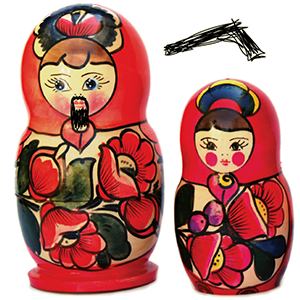A red herring is a literary tactic of diverting attention away from an item of significance. For example, in mystery fiction, where the identity of a criminal is being sought, an innocent party may be purposefully cast in a guilty light by the author through the employment of false emphasis, deceptive clues, ‘loaded’ words, or other descriptive tricks of the trade. The reader’s suspicions are thus misdirected, allowing the true culprit to go (temporarily at least) undetected. A false protagonist is another example of a red herring.
In a literal sense, there is no such fish species as a ‘red herring’; rather it refers to a particularly ‘strong kipper’ (a fish that has been strongly cured and smoked making it pungent smelling and reddish in color).
read more »
Red Herring
Chekhov’s Gun
Chekhov’s gun is a literary technique whereby an element is introduced early in the story, but its significance does not become clear until later in the narrative. The concept is named after Russian playwright Anton Chekhov, who mentioned several variants of the concept in letters. Chekhov himself makes use of this principle in ‘Uncle Vanya,’ in which a pistol is introduced early on as a seemingly irrelevant prop and, towards the end of the play, becomes much more important as Uncle Vanya, in a rage, grabs it and tries to commit homicide.
The phrase ‘Chekhov’s gun’ is often interpreted as a method of foreshadowing, but the concept can also be interpreted as meaning ‘do not include any unnecessary elements in a story.’ Failure to observe the rule of ‘Chekhov’s gun’ may be cited by critics when discussing plot holes. The opposite of Chekhov’s gun is a ‘red herring,’ a plot device that’s designed to divert attention.
Herman’s Hermits
Herman’s Hermits is an English pop band, formed in Manchester in 1963. For a brief time the group rivalled the Beatles on the charts, and was the top-selling pop act in the U.S. in 1965. The group’s manager and producer, Mickie Most (who controlled the band’s output), emphasized a simple, non-threatening and clean-cut image, although the band originally played R&B numbers. This helped Herman’s Hermits become hugely successful in the mid-1960s but hampered the band’s creativity, relegating Noone, Hopwood, Leckenby and Green’s original songs to quickly recorded B-sides and album cuts.
Their first hit was a cover of Earl Jean’s ‘I’m Into Something Good’ (written by Gerry Goffin and Carole King), which reached No. 1 in the UK Singles Chart and No. 13 in the US in 1964. They never topped the British charts again, but had two US Billboard Hot 100 No. 1’s with ‘Mrs. Brown, You’ve Got a Lovely Daughter’ and ‘I’m Henry the Eighth, I Am’ (a British music hall song dating from 1911). These songs were aimed at a US fan-base, with Peter Noone exaggerating his Manchester accent; the band was not fond of either song and they were never released as singles in Britain.
RTFM
RTFM (‘read the fucking manual’) is a brusque way to remind others to try to help themselves in obvious ways before seeking assistance from others. Since the rise of the Web, pervasive internet connectivity, and ubiquitous search, a similar type of response has involved the idea that by asking questions that could easily be answered by even the most cursory, obvious search, the user embarrasses himself by showing that the very idea of searching before asking didn’t even occur to him.
The most common variants of this type are GIYF (‘Google is your friend’) and LMGTFY (‘let me google that for you’), both with a tone of patronizing helpfulness (with varying degrees of sarcasm).Often the responder will even insert a link into the reply that, when the user clicks it, will take them to a saved search query. The clear implication is that’you should know by now to do this yourself.’
Giant’s Causeway
The Giant’s Causeway is an area of about 40,000 interlocking basalt columns, the result of an ancient volcanic eruption. It is located on the northeast coast of Northern Ireland. The tops of the columns form stepping stones that lead from the cliff foot and disappear under the sea. Most of the columns are hexagonal, although there are also some with four, five, seven and eight sides. The tallest are about 12 metres (36 ft) high, and the solidified lava in the cliffs is 28 metres thick in places.
MacGuffin
A MacGuffin is a plot element that catches the viewers’ attention or drives the plot of a work of fiction. The defining aspect of a MacGuffin is that the major players in the story are (at least initially) willing to do and sacrifice almost anything to obtain it, regardless of what the MacGuffin actually is. In fact, the specific nature of the MacGuffin may be ambiguous, undefined, generic, left open to interpretation or otherwise completely unimportant to the plot. Common examples are money, victory, glory, survival, a source of power, or a potential threat, or it may simply be something entirely unexplained.
The MacGuffin is common in films, especially thrillers. Usually, though not always, the MacGuffin is the central focus of the film in the first act, and then declines in importance as the struggles and motivations of characters play out. It may come back into play at the climax of the story, but sometimes the MacGuffin is actually forgotten by the end of the film. The director and producer Alfred Hitchcock popularized both the term and the technique, with his 1935 film ‘The 39 Steps,’ an early example of the concept.
Pascha
The Pascha is a 12 story brothel in Cologne, Germany. With about 120 prostitutes, over 80 employees and up to 1000 customers per day, it is the largest brothel in Europe. The brothel was opened in January 1972 in the Hornstraße, under the name ‘Eros Center.’ It was Europe’s first high rise brothel. The city of Cologne wanted to eliminate the red light district ‘Kleine Brinkgasse’ in the city center and issued a license to build the new brothel on land owned by the city in the outskirts of town. The house rents 126 rooms on 7 floors to prostitutes for a fee of 180 Euros per day, which includes meals, medical care, and the 20 Euros of tax that authorities collect per prostitute per day.
The women come from many countries; about 30% of them are German. They typically sit outside of their rooms and negotiate with customers who wander the hallways. Some of the women live in their rooms, others rent a second room to stay in, while still others stay in their own apartments in Cologne. The house is open 24 hours a day; customers of the prostitutes pay an entrance fee of 5 Euros and then negotiate directly with the women, who work independently and keep all of the money. One floor is reserved for low-cost service, and another one for transsexual prostitutes. The house also contains a regular hotel, a table dance nightclub with separate entrance, several bars, and a separate club-style brothel on the top floor.
Wabi-Sabi
Wabi-sabi represents a comprehensive Japanese world view or aesthetic centered on the acceptance of transience. The aesthetic is sometimes described as one of beauty that is ‘imperfect, impermanent and incomplete.’ It is a concept derived from the Buddhist assertion of the Three marks of existence (impermanence, suffering, and non-self).
Characteristics of the wabi-sabi aesthetic include asymmetry, asperity, simplicity, economy, austerity, modesty, intimacy and appreciation of the ingenuous integrity of natural objects and processes.
read more »
Mono No Aware
Mono no aware (literally ‘the pathos of things’), also translated as ‘an empathy toward things,’ or ‘a sensitivity of ephemera,’ is a Japanese term used to describe the awareness of ‘mujo’ or the transience of things and a gentle sadness (or wistfulness) at their passing. The term was coined in the eighteenth century by the Edo period Japanese cultural scholar Motoori Norinaga, and was originally a concept used in his literary criticism of ‘The Tale of Genji,’ and later applied to other seminal Japanese works including the ‘Man’yōshū,’ becoming central to his philosophy of literature, and eventually to Japanese cultural tradition.
The word is derived from the Japanese word ‘mono’ (lit. ‘things’) and ‘aware,’ which was a Heian period expression of measured surprise (similar to ‘ah’ or ‘oh’), translating roughly as ‘pathos,’ ‘poignancy,’ ‘deep feeling,’ or ‘sensitivity.’ Thus, mono no aware has frequently been translated as “the ‘ahh-ness’ of things,” life and love. The quintessentially ‘Japanese’ director Yasujiro Ozu was well known for creating a sense of mono no aware, frequently climaxing with a character saying a very understated ‘ii tenki desu ne’ (‘It is fine weather, isn’t it?’), after both a familial and societal paradigm shift, such as daughter being married off, against the backdrop of a swiftly changing Japan.
Saudade
Saudade is a Portuguese word difficult to translate adequately, which describes a deep emotional state of nostalgic longing for something or someone that one was fond of and which is lost. It often carries a fatalist tone and a repressed knowledge that the object of longing might really never return. Saudade has been described as a ‘vague and constant desire for something that does not and probably cannot exist … a turning towards the past or towards the future.’ A stronger form of saudade may be felt towards people and things whose whereabouts are unknown, such as a lost lover, or a family member who has gone missing.
It may also be translated as a deep longing or yearning for something which does not exist or is unattainable. Saudade was once described as ‘the love that remains’ or ‘the love that stays’ after someone is gone. Saudade is the recollection of feelings, experiences, places or events that once brought excitement, pleasure, well-being, which now triggers the senses and makes one live again.
Sehnsucht
Sehnsucht is a German noun translated as ‘longing,’ ‘yearning’ and ‘craving,’ or in a wider sense a type of ‘intensely missing.’ The word is almost impossible to translate adequately and describes a deep emotional state. Its meaning is somewhat similar to the Portuguese word, ‘saudade.’ The stage director and author Georg Tabori called Sehnsucht one of those quasi-mystical terms in German for which there is no satisfactory corresponding term in another language.
The term is a compound word, originating from an ardent longing or yearning (‘das Sehnen’) and addiction (‘die Sucht’). However, these words do not adequately encapsulate the full meaning of their resulting compound, even when considered together.
read more »
Persepolis
Persepolis is a French-language autobiographical comic by Marjane Satrapi depicting her childhood up to her early adult years in Iran during and after the Islamic revolution. The title is a reference to the ancient capital of the Persian Empire, Persepolis. Drawn in black and white, the graphic novel found great popularity following its release, and was translated into several languages. The English edition combines the first two French books and was translated by Blake Ferris and Satrapi’s husband, Mattias Ripa.
In 2007, an animated film adaptation of the graphic novel was created, with author Satrapi co-directing with French comic artist Vincent Paronnaud. The film utilized the same style of the graphic novel, although there are a handful of scenes in the present day that are shown in color, while the rest of the flashback events are illustrated in black and white, as in the novel.
















